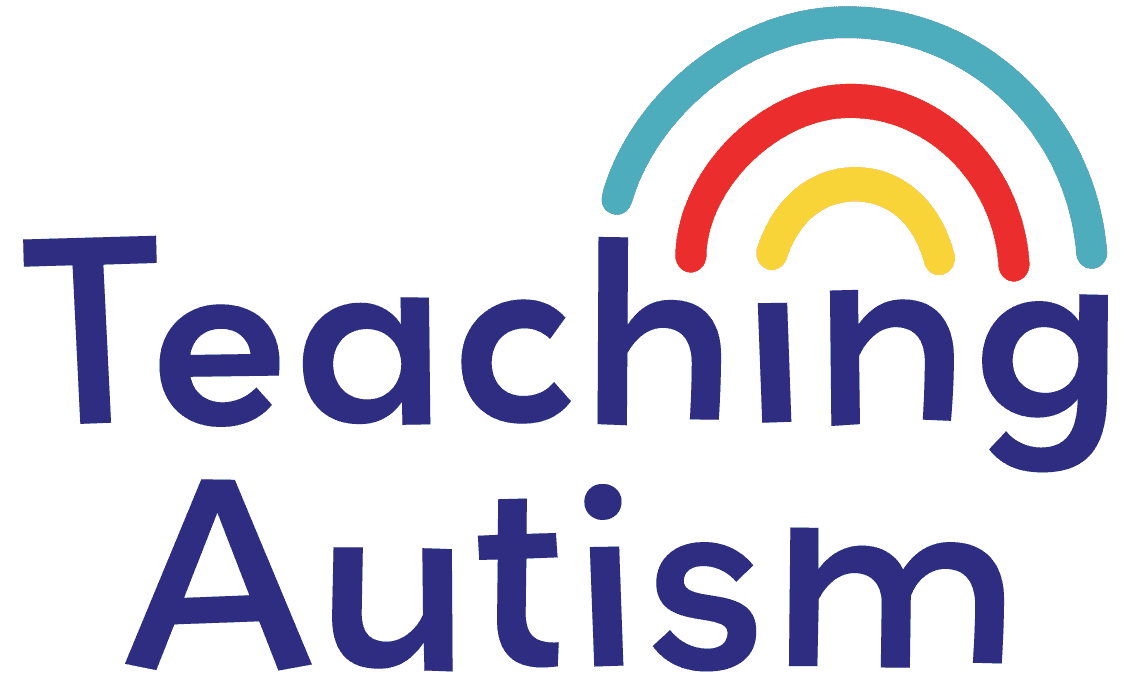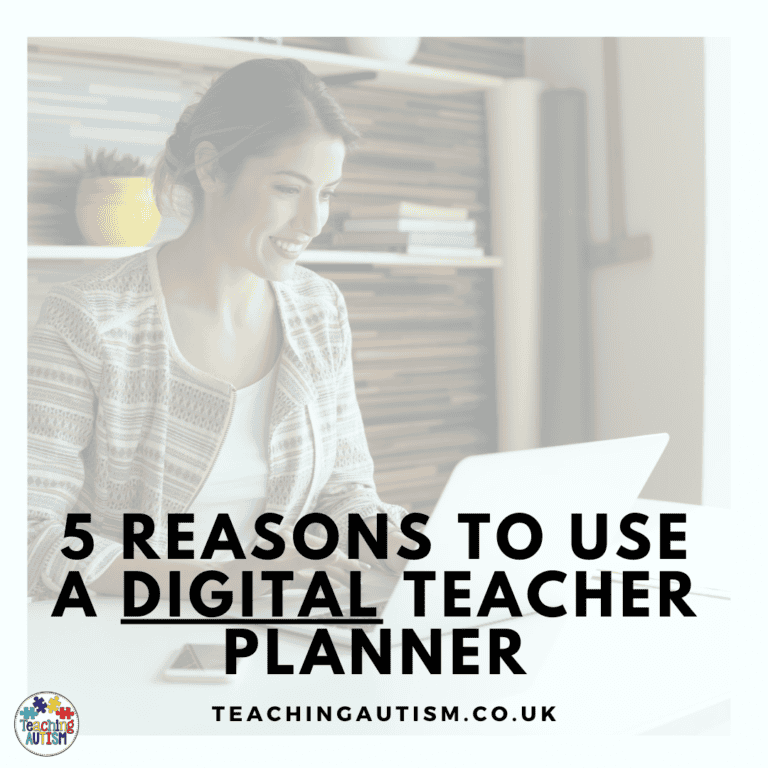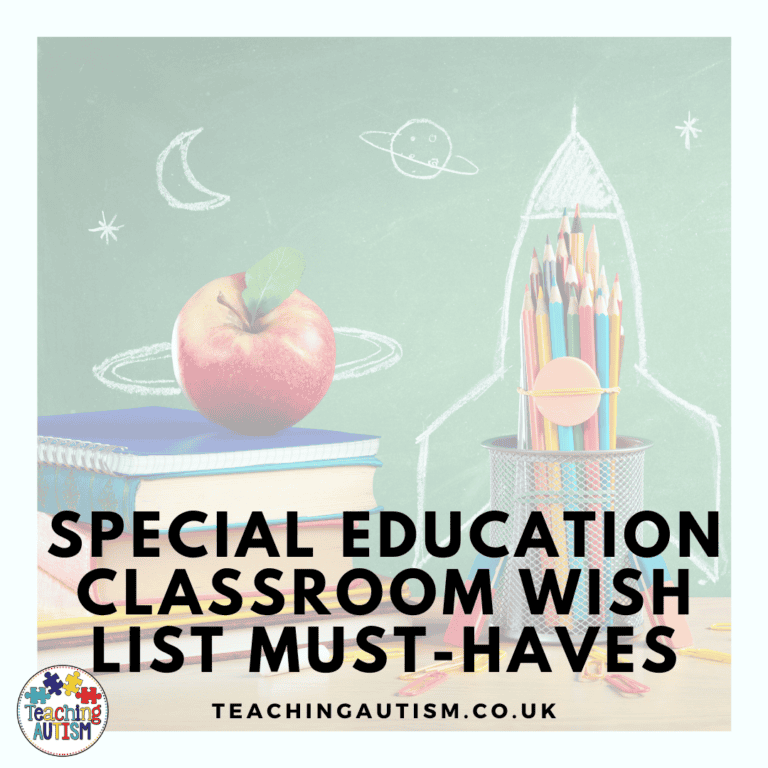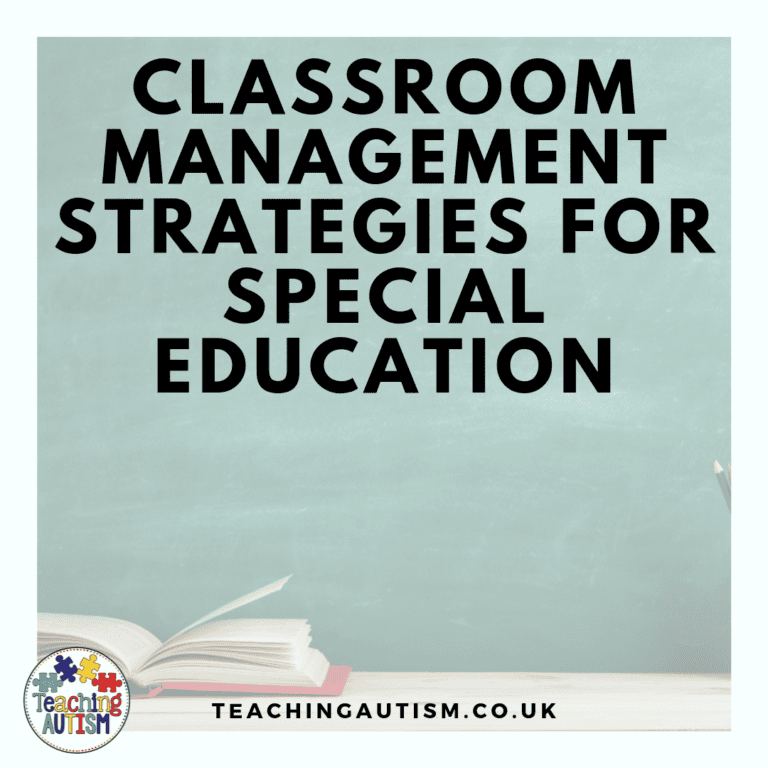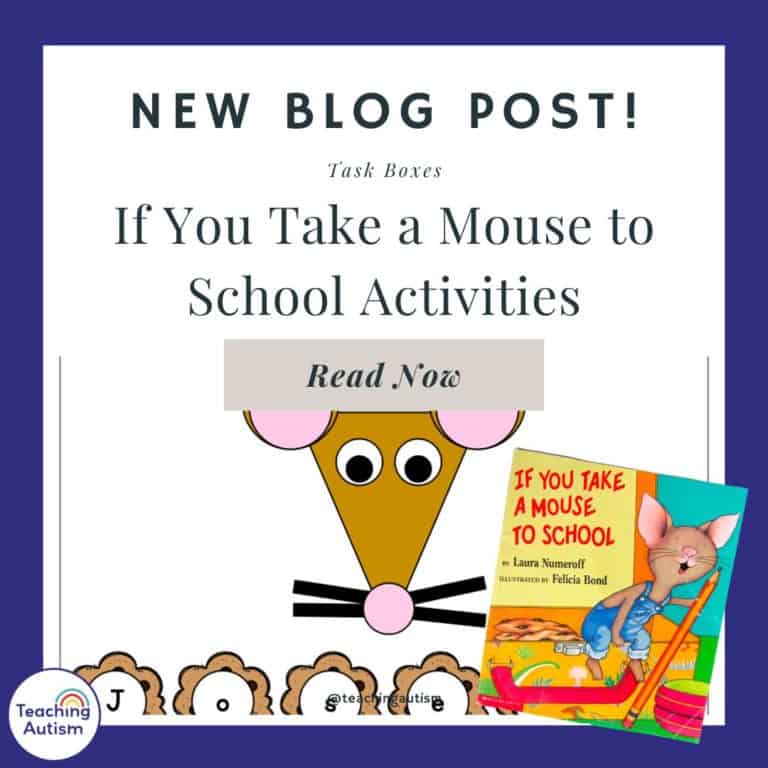What to Teach on the First Week of School Special Education
Special education teachers everywhere have been hitting up my Instagram DMs the last few weeks asking me all of the questions about what to teach on the first week of school. And after much back and fore and surveys, I realized it was probably time for to me to put my fingers to the keyboard and share with you all my first week of school schedule, lesson plans and resources that you can use too!
First of all, if you’re a first time teacher, don’t panic. I think that is the biggest mistake everyone will ever tell you about. It’s so easy to get caught up in a panic about doing all of the things that first week that so many of us forget to just slow down and enjoy it. So, if you take away anything from this blog post today, please let it be to slow down, enjoy your first week getting to know your students and staff and try not to stress!
What to Teach on the First Week of School
I always see mixed reactions from teachers when people start to discuss what to teach the first week of school. You’ll hear people talk about teaching nothing, teaching everything, and all the things in between. For me, it’s a time where I like to teach the most important things that will pay off through the year, and they are;
- Classroom rules and expectations.
- Routines/schedules.
- Layout and where things are.
Other things that I like to use this time to focus on are;
- Building relationships with students and staff.
- Chance for students to get to know their peers and staff members and build relationships.
- Opportunity to identify student’s interested, hobbies and motivational objects.
Now, I feel like sometimes these things are easier said than done. It sounds so easy to spend time working on these things, such as classroom rules, but it took a long time for me to find ways that really work for my students to benefit from working on classroom rules and really understand what I was trying to teach. So in this blog post today, not only am I going to share my schedule with you for that first week, but also resources, and links to activities that I use as well.
Schedule
The schedule for my first week follows my schedule for the entire year. I always find it very important that my students have a routine that they can get used to and follow. However, that’s not to say that I stick rigidly to it. There’s many opportunities through the year where things get moved around, and I try to work on helping students manage dealing with change within our schedules and routines as well.
This schedule is one that has worked for me for a long time, and I’ll do a separate blog post discussing my schedule more in detail, and how I make small tweaks to it each week but generally follow this for the entire school year as my baseline.
For me, my staff, and my students, it’s really important to me that we start the year off as we mean to go on. Now, I do tend to be a lot more lenient with students during those first few weeks and I generally use a lot of the times to do assessments and baseline my students. But it generally still fits within this schedule.
My Weekly Schedule
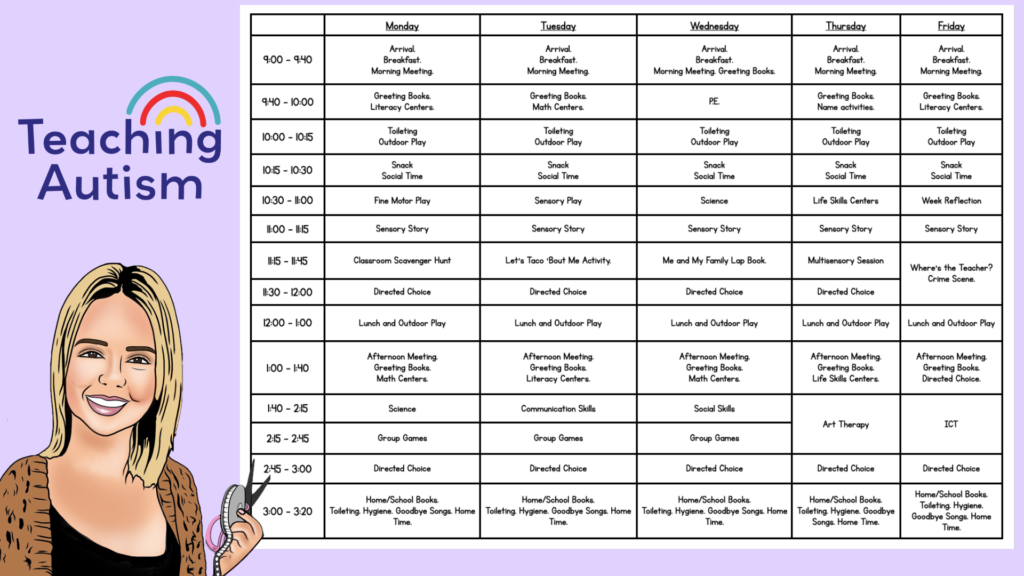
Download a PDF copy of my schedule here.
What I tend to do with this schedule is each week change up the generic lessons to what the actual lessons are. So, instead of ‘Science’ I’ll put, gummy bear science experiment. I’ll also add mine and my assistant’s initials in sections so everyone knows where they are and who is with what student(s).
For helping my students understand and be aware of the routine, I use mini schedules on the wall. Each student has their own schedule. They run horizontally, not vertically. This is because it follows the natural order of reading – from left to right – rather than top to bottom. Student’s are able to recognize their schedules by having their own photo next to their schedule, and everyone having their schedules the same color as their color in the classroom. (I love to use a color co-ordinated classroom.. And this is one of my most requested blog posts, so I’ll be putting one together soon!) This means that I can also vary student’s schedules where needed especially if student’s are called at different times for speech and language therapy etc.
Activities
Breakfast and Morning Meeting
First we will concentrate on the first morning period, as everyone also wants to know more about this. As our students arrive, they come into class and sit at the group table with staff to have breakfast. This is one of the most important parts of our day because it helps us to ensure that our students have had breakfast and access to some good food before starting the day and placing demands on them. It’s also an opportunity for us to sit with students, socialize and spend time building those strong relationships.
During breakfast, my students will communicate verbally, using sign language, using our symbol communication books or Proloquo2Go on the iPad.

To increase our opportunities for socialization during this time, and taking pressure off students to try and think of conversation starters, we use two different resources. First, we use these question of the day cards. These are great questions for us getting to get to know each other, and encouraging students to ask each other questions and find out what their answers are.

To continue conversations flowing, we then use these conversation starter task cards. Students all take turns taking one card out of the pile and use it to ask another student or staff member a question. This is another great opportunity to find out more about each other, build relationship skills and also work on those all important social and communication skills. Through the year I mix them up and use Halloween and Christmas conversation starters.

This is also an opportunity for students to sit and choose their lunch options for the day as well, while staff are able to help unpack students bags and read through the home/school communication books.

For morning meeting, we all gather around the IWB. Our morning meeting is an interactive PowerPoint and it includes the following slides;
- Good Morning Song.
For this, I create a video using a good morning themed song using photos of students. At the start of the year it’s the generic video off YouTube. But as I gather photos I will put these together using photos of staff and students in with the song so students can see themselves visually on the board as well. - Attendance Check-in.
Students need to click their face on the board to ‘check in’ for the day. This is where I always find it really important to try and get hold of photos of students before the start of the school year so you can have this set up ready. - Counting Students.
Nominate a student each day to stand up and tap the heads of their peers to count how many students are in school. When they have their answer, they choose the matching number on the IWB. - Days of the Week
Use a video of a ‘Days of the Week’ song and encourage students to dance, sing or sign along. When the song is finished, on the next slide, nominate a student to approach the IWB and click the day of the week that it is. - How’s the Weather?
Use a video of a ‘How’s the Weather?’ song and again encourage students to join in through dancing, singing or signing. When the song is finished, on the next slide, nominate a student to approach the IWB and click what the weather is. The slide after this is a teddy bear where students then have to click and drag the clothing items onto the bear to dress appropriately for the weather today. This is a perfect way to help students prepare for outdoor play etc and how to dress in different types of weather. - Feelings
Use a video about feelings and once again encourage students to join in. Once the song is finished, students have a slide each with their face on and symbols of different feelings/emotions. Ask students to go up to the IWB on their slide to choose how they are feeling. There are so many great learning opportunities linked with this and I love using it as an opportunity to discuss student’s feelings and emotions with them and helping them to understand how and why they feel that way. - Time to Work
To end the morning meeting I like to put in a fun and upbeat song with a bunch of different GIFs full of praise, encouragement and positivity. My kids always love this and it’s a great way for us to go off and start our work for the day.
Greeting Books and Centers
For our first work of the day, we always start with our morning work book. This provides a consistent approach to work everyday with my students and gets them working on important daily skills. It also helps to prepare them for the day and that work is coming next. Click here to read about what is included in our morning work books and what skills we work on with them.

After this is when we begin to work. So I generally leave this quite open ended as literacy or math centers because when I do my lesson plans I’ll put more detail in. But generally this time slot looks like;
- 3 students work 1:1 with staff members in the work room working through their work tray. This can usually be task boxes, adapted books or work binders. These are tailored to the individual student’s needs and targets and what they are to be working on.
- The rest of the students will be accompanied by the remaining staff, usually 3-4 students and 2 staff members. They will be in the main area of the classroom and there will be centers set out. As an example, for literacy centers I may have 3 tables laid out for students to rotate between. Table 1 will be these free name play-dough mats. Table 2 will have this letter recognition game. Table 3 will have some different picture books out for students to look through.
For the rest of the schedule, I will break down the different elements of the schedule into smaller parts below except for generic parts which will be clear, i.e. P.E., toileting, lunch.
First Week Specific Activities
These activities and resources are specifically what I focus on at the start of every year and they are;
- Being a Good Friend Task Cards (Free Download)
- Working on Good Manners (Free Download)
Fine Motor Play
I find it easiest to pull of my fine motor task boxes each time for this center as well as rotating through some different fine motor activities depending on what the current theme is, season or holiday we are learning about.

Some of my go to toys for working on fine motor skills with my students are;
Links to toys may contain affiliate links.
Sensory Story
I talk more about sensory stories in this podcast episode here. As an example, you can also check out this free sensory story script that I provide for Christmas time. And if you’re a VIP member you have access to a huge library of sensory story scripts, with ones perfect to use all year long.
Math Centers
I typically like to have 3 table centers set up so that students can rotate between them without feeling too overcrowded. At the start of the year I like to make these really fun, engaging and hands-on. And while I try to do this year long for my students, that first week is usually a lot more fun to try and really get my students engaged and wanting to work.
Some of my favorite math centers to have out are;
- Math Task Boxes
- Shark Eating Numbers (Free Download)
- School Bus Ten Frames
- Dinosaur Number Hunt – I love to pop this one in a sensory tub and it’s always a fun one for the first week!
I also like to have the IWB on as an option for a center as well. And these free color matching Boom Cards are always a hit with my students!

Literacy Centers
For the literacy centers, especially for that first week of school, I tend to focus on student’s names, all about me activities, families and spending time at these centers getting to know students more. I also love to spend time putting together ‘Our Class is a Family’ book where students can draw themselves and write their names, and then we put it altogether as a class book. My students love doing it, and we even get staff involved as well. You can download it for free here.

For the name activities, my favorite go-to activities are usually;
- Name Play-Dough Mats. (Free Download)
- Writing my Name Worksheets. (I laminate them.) (Free Download)
- My Name Journal.
- Crayon Spelling Task Box. (Free Download)
- Name Flip Book.
- Alphabet Name Worksheets.

For the ‘all about me’ activities, my favorite go-to activities are usually;

Since I love to read the book ‘Chicka Chicka Boom Boom’ at the start of the year, I also like to use the following activities;
- Coconut Alphabet Task Box (Free Download)
- Coconut Splat CVC Words (Free Download)

Science
Each week for science we do one cookery activity and one science experiment. For the first week of school, we like to ease our students in and not overwhelm them. So, for the science experiment we like to use the rainbow skittle one where you place skittles on the outside middle of a plate in a circle, then pour cold water in the middle of the plate. As the water reaches the skittles on the outside, the colors leak making an amazing rainbow. It’s a quick and fun experiment for students to do.
For cookery, we also start off slow working on following instructions and recipes without overwhelming students. So we make a school bus! We use a rectangle cracker for the bus, smooth yellow icing across the cracker, use small square cereal pieces for the windows, and split an Oreo in half to use as two wheels for the bus! We then eat them together during snack time. It’s a fun and quick cookery session with lots of different learning opportunities available; colors, shapes, counting etc.
Group Games
For group games we like to put students and staff together into small groups to play games together. We generally rotate through the different board games that we have in our cupboard, and we will let students choose which games each week as well. There are so many amazing skills to work on with students when playing group games. And this really does give us a chance to spend more time with students, socialize and build those all important relationships.
Directed Choice
Sometimes it throws people when I say I don’t have just free choice, but directed choice. And honestly, the answer to this is just because I’ve found over the years that students just find free choice to overwhelming. And it’s also really hard for students during that first week to just tell them they have free choice because they don’t know what their options are, what is in the classroom, where things are, what they can choose etc. So this is where directed choice is an extra bonus.
For directed choice, I provide each student with their own choice board. On that choice board are different symbol options of choices that students can choose. I change them up regularly to rotate through different options and it also means that they won’t be choosing things that I really need to say ‘no’ to for different reasons. These are the choice boards that I use with my students.

Communication Skills and Social Skills
These sessions I typically liaise with our speech and language team for to have them come in and help me see what my students really need to work on. Then I make up some activities for students to work on for those skills. I try to keep a dedicated block in my schedule to this, and I’ll often liaise with the specialists through the year to see if there’s anything I need to change up, add in or take out.
Thursday
If you have been here for a while, you’ll remember that I’ve discussed my special ‘Thursday’ with you all before. But in case you’re new here and don’t know what I’m talking about.. Thursday in my classroom is always ‘Therapy Thursday’ and it’s where we really take away all worksheets and stuff like that for the day and we focus on working on therapies and other important skills such as;
- Life skills.
- Music therapy.
- Art therapy.
- Multisensory sessions.
There’s also speech and language and often story massage done on these days as well. I like to mix up and have it as a really hands-on day for my students – and obviously, this looks slightly different each year depending on the students I have too!
Click here to find out all about Therapy Thursday’s in my classroom.
Some of my favorite activities to use on a Thursday are;
- Life Skills Adapted Binder
- Life Skills Adapted Books
- Task Boxes for Life Skills
- Multi-Sensory Lesson Plans
- Art Therapy Lesson Plans
You can find out more about the art therapy sessions that I run here.

Afternoon Work Book
You’ll also notice in my schedule that I mention an afternoon work book. This is similar to the morning work book that I discussed earlier on in this blog post. But you can also find out more about the afternoon one here.

Crime Scene
At the end of the first week I love to put together this crime scene where I’ve been kidnapped! Students and remaining staff in the classroom have to work together to solve the clues around the crime scene and work out who has taken me! It’s always a huge hit and a fun way to end the week. It also means that they finish up Friday having a bunch of fun.
Let’s face it. By Friday on that first week, we are all exhausted and the last thing we want to be doing is sat behind a desk! This crime scene is a fun way to get up, moving around and just having fun with a more hands-on and engaging activity.
Read all about the crime scene here, or download your own copy to use with your students here.

End of Week Reflection
At the end of the week, I set students up on the app BookCreator one at a time with 1 member of staff helping them. Students get to input pictures from their first week onto the comic strip and write down a short description of what they did that week, and any comments they have. We continue this all year long on a Friday and by the end of the year each student has their own memory book of the year – it’s also perfect for using as photographic evidence! (Staff also put together similar ones for IEP targets where each student has their own BookCreator book for IEPs. Then on each page of the book is their IEP target. We use the comic templates so that we can add a number of photographs or videos as evidence for working on that IEP target as well as comments.
My Top Tips
This blog post ended up being a lot longer than I originally planned but I hope you find that it is full of helpful information! I thought I would do a quick round up at the end here with my top tips for when you are planning your schedule fo rhte first week of school;
- Work on classroom rules with your students and what you expect of them.
- Set up your routine and help students settle into this. Don’t be afraid to give it a little bit of time and then make tweaks if necessary.
- Find time to sit down with students and really get to know each other and build relationships, this will be a huge benefit for the rest of the year.
- Remember this is a new environment for your students – and may be all new staff and peers for them as well! So provide opportunities to help them settle in. We love to do scavenger hunts around the classroom and school to help students become more aware of their surroundings and where things are in the classroom.
- Set up communication systems with your students families. How will you communicate back and fore? We love to use communication books. But I’ll also let families know that on a Friday I’ll send them home a copy of the page they made in their BookCreator app. And I’ll use email for sending home monthly newsletters too – unless they opt to have them printed and sent home with students.
If you’re a new teacher, or new to teaching within special education and you’re feeling overwhelmed with what resources to prep and get ready for the new school year, I can help you out! I put together a bundle of my most used and valuable resources in this Autism Classroom Set-Up Bundle – and I can’t begin to tell you how much feedback it has had from teachers all around the world who have found it such a time saver and life saver to use with their students. So, if there’s one thing I highly recommend you get in advance and prep for your students this year, it’s this bundle! It has almost everything you could possibly need to get your classroom up and running.

P.S. Have you signed up for a 3 day free trial of our VIP membership yet? If not, click here to do it now and go and get access to a huge range of resources, templates, crafts and more for free.
How are you preparing for the first week of school? Let me know in the comments below.
Nikki
